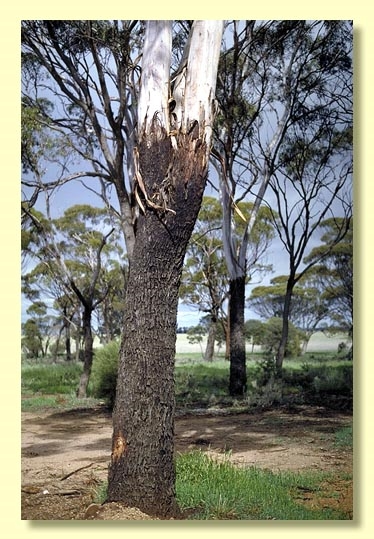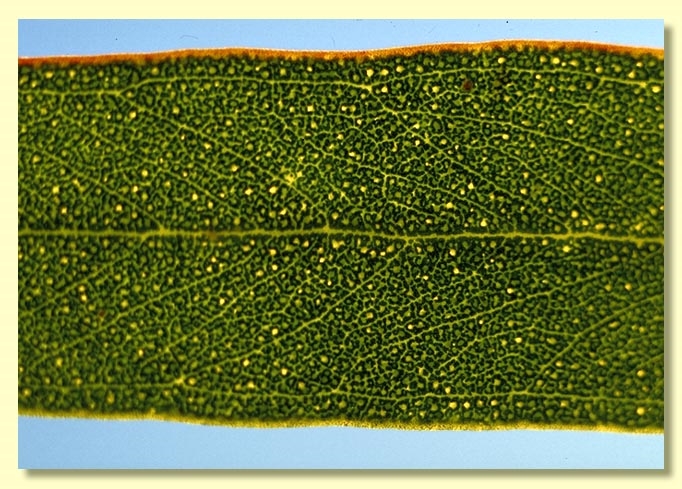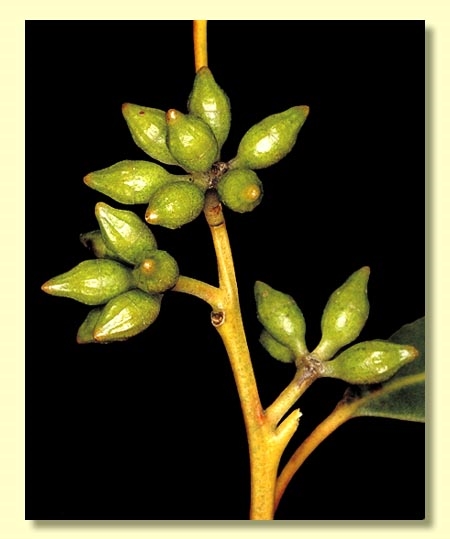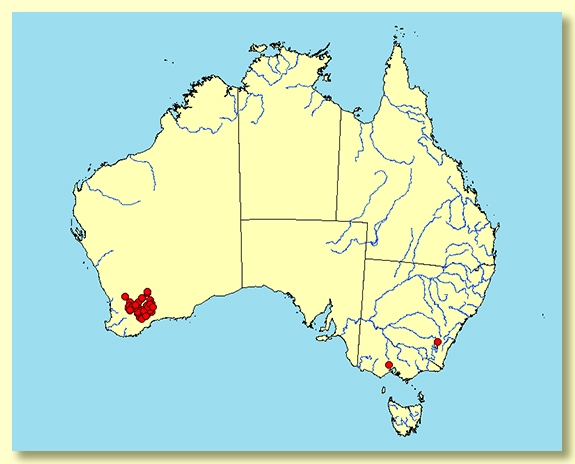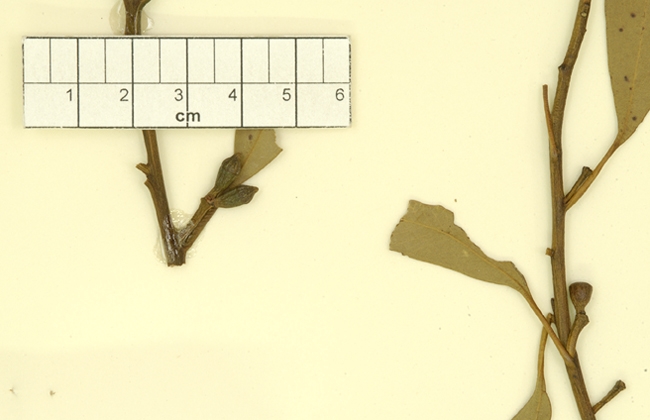Euclid - Online edition
Eucalyptus kondininensis
Eucalyptus | Symphyomyrtus | Dumaria | Rufispermae
T: Kondinin, W.A., 30 Oct. 1922, C.A.Gardner 1843; syn MEL, NSW, PERTH; Kondinin, W.A., 9 July 1923, C.A.Gardner 1966; syn CANB, K, NSW, PERTH.
Bark rough, black or less commonly dark grey-brown, coarsely flaky and fissured to hard and compact for half or entire trunk, branches smooth, grey to white over orange to yellow.
Branchlets with oil glands in pith.
Juvenile growth (coppice or field seedlings to 50 cm): stems square in cross-section; juvenile leaves always petiolate, alternate, lanceolate, 5.5–8 cm long, 1–1.5 cm wide, grey-green to green.
Adult leaves alternate, petioles 1–2 cm long; blade lanceolate or becoming slightly falcate, 6–10.8(11.7) cm long, 0.6–1.2(1.8) cm wide, base tapering to petiole, margin entire, apex acute, glossy, green, side-veins at an acute or wider angle to midrib, reticulation usually dense, intramarginal vein remote from margin, oil glands intersectional.
Inflorescence axillary unbranched, peduncles 0.5–1.4 cm long, buds 7 per umbel, sessile or rarely very shortly pedicellate (pedicels 0–0.2 cm long). Mature buds more or less ovoid (0.7–1.1 cm long, 0.4–0.5 cm wide) but operculum may be wider than or equal to hypanthium at the join, scar present, operculum conical or shortly beaked (0.4–0.5 cm long), stamens inflexed, anthers cuboid to wedge-shaped, versatile, dorsifixed, dehiscing by longitudinal slits, style straight, long, stigma rounded to tapering, locules 3 or 4, the placentae each with 4 vertical rows of ovules. Flowers white.
Fruit sessile or rarely shortly pedicellate (pedicels 0–0.2 cm long), cupular to obconical, 0.4–0.6 cm long, 0.4–0.7 cm wide, disc descending, valves 3 or 4, near rim level or only slightly exserted.
Seeds reddish brown and glossy, 0.8–2 mm long, flattened-ovoid and often angular in outline, dorsal surface sometimes lacunose, shallowly reticulate, hilum ventral.
Cultivated seedlings (measured at ca node 10): cotyledons reniform; stems square in cross-section; leaves always petiolate, opposite for 3 to 5 nodes then alternate, ovate, 6.5–8.5 cm long, 2.5–3.5 cm wide, dull, green.
Flowering has been recorded in February and April.
Eucalyptus kondininensis has value in the reclamation of saline soils. The tree form of E. kondininensis has been recorded as being naturalized in Victoria in the farming district of Glenmore, near Bacchus Marsh, where it has spread from soil conservation plantings.
There are two forms of Eucalyptus kondininensis informally recognised in EUCLID:
E. kondininensis subsp. kondininensis
The well-known single-stemmed tree form which may either have or lack a lignotuber (i.e. is either a tree capable of resprouting basally, or alternatively, is a mallet).
E. kondininensis subsp. tuberosa
This mallee form is found in the the wheatbelt area south of Cunderdin, and from Narrogin to Harrismith, Kulin, Yealering, Bullaring to Pingelly, on gravelly lateritic soils on low hills and rising ground. It is distinguished only by its mallee habit.
In bud and fruit features, Eucalyptus kondininensis resembles E. phenax subsp. phenax which differs by its mallee habit, smooth bark and fruit slightly longer than wide. E. kondininensis has a more south-westerly distribution than any other rough-barked tree species in series Rufispermae. Of these rough-barked trees E. kondininensis subsp. kondininensis has narrow, glossy leaves and the branchlets, buds and fruits are non-glaucous compared with the dull-leaved E. clelandii and the glossy, coarse-leaved E. lesouefii, whereas the more northerly E. striaticalyx has dull grey-green leaves, is non-glaucous, has slightly larger buds and fruits and more extensive rough bark. E. polita, a smooth-barked mallet that occurs on comparatively elevated sites from south of Marvel Loch (Mt Caudan area) towards Norseman, has very similar buds, fruit and adult leaves to E. kondininensis.
In the classification of Brooker (2000) Eucalyptus kondininensis belongs in Eucalyptus subgenus Symphyomyrtus section Dumaria having these features: buds initially with two opercula the outer shed early, stamens strongly inflexed, ovules in 4 rows on the placentae and cotyledons reniform. Within section Dumaria the species belongs to a large sub-group of closely related species (series Rufispermae, 37 described species and subspecies) diagnosed by glandular pith in the branchlets, anthers cuboid to wedge-shaped, versatile, and by the reddish brown and glossy, flattish seeds which are unique to the series.
Eucalyptus kondininensis: referring to the town of Kondinin, Western Australia.


